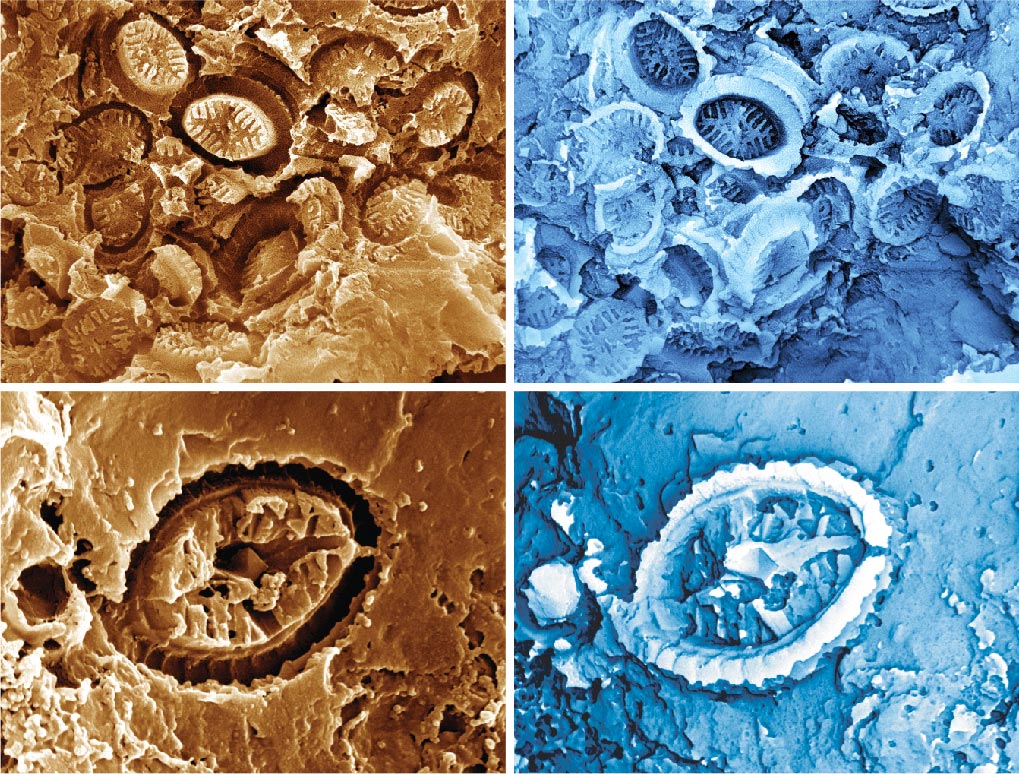As imagens mostram impressões de uma cobertura de parede celular colapsada (cocosfera) na superfície de um fragmento de matéria orgânica antiga (esquerda) com placas individuais ampliadas (cóccix) para mostrar a notável preservação de estruturas em escala submicrométrica (direita). A imagem azul é invertida para dar uma imagem fóssil virtual, ou seja, para mostrar a forma 3D original. As lajes originais foram removidas do sedimento por dissolução, deixando apenas vestígios de fantasmas. Crédito: S.M. Slater, P. Bowen/Science Journal
Uma equipe internacional de pesquisadores descobriu um novo tipo de fossilização.
A descoberta de fósseis ‘fantasmas’ revela a resiliência do plâncton em face de eventos de aquecimento global passados.
Uma equipe internacional de cientistas da University College London (UCL), do Museu Sueco de História Natural, do Museu de História Natural (Londres) e da Universidade de Florença encontrou um tipo notável de fossilização que permaneceu praticamente despercebido até agora.
Fósseis são impressões digitais microscópicas, ou “fantasmas”, de plâncton unicelular, chamados cocolitóforos, que viveram nos mares há milhões de anos, e sua descoberta revolucionou nossa compreensão de como as mudanças climáticas afetam o plâncton nos oceanos.
Os cocolitóforos são importantes nos oceanos de hoje, fornecendo grande parte do oxigênio que respiramos, sustentando as teias alimentares marinhas e retendo o carbono nos sedimentos do fundo do mar. Eles são um tipo de plâncton microscópico que cerca suas células com lajes de calcário duro, chamadas de cocólitos, que geralmente se decompõem nas rochas.
A diminuição da abundância desses fósseis foi documentada a partir de vários eventos de aquecimento pré-global, indicando que esses plânctons foram severamente afetados pelas mudanças climáticas e pela acidificação dos oceanos. No entanto, um estudo foi publicado hoje na revista Ciência Apresenta novos recordes mundiais para os abundantes fósseis fantasmas de três[{” attribute=””>Jurassic and Cretaceous warming events (94, 120, and 183 million years ago), suggesting that coccolithophores were more resilient to past climate change than was previously thought.

The individual plates are coccoliths. Credit: Images from Nannotax https://www.mikrotax.org/Nannotax3/
“The discovery of these beautiful ghost fossils was completely unexpected,” says Dr. Sam Slater from the Swedish Museum of Natural History. “We initially found them preserved on the surfaces of fossilized pollen, and it quickly became apparent that they were abundant during intervals where normal coccolithophore fossils were rare or absent – this was a total surprise!”
Despite their microscopic size, coccolithophores can be hugely abundant in the present ocean, being visible from space as cloud-like blooms. After death, their calcareous exoskeletons sink to the seafloor, accumulating in vast numbers, and forming rocks such as chalk.

The fossils are approximately 5 µm in length, 15 times narrower than the width of a human hair. Credit: S.M. Slater, P. Bown et al. / Science journal
“The preservation of these ghost nannofossils is truly remarkable,” says Professor Paul Bown (UCL). “The ghost fossils are extremely small ‒ their length is approximately five-thousandths of a millimeter, 15 times narrower than the width of a human hair! ‒ but the detail of the original plates is still perfectly visible, pressed into the surfaces of ancient organic matter, even though the plates themselves have dissolved away.”
The ghost fossils formed while the sediments at the seafloor were being buried and turned into rock. As more mud was gradually deposited on top, the resulting pressure squashed the coccolith plates and other organic remains together, and the hard coccoliths were pressed into the surfaces of pollen, spores, and other soft organic matter. Later, acidic waters within spaces in the rock dissolved away the coccoliths, leaving behind just their impressions – the ghosts.

Ghost nannofossils were found in rocks from global warming intervals where normal coccolithophore fossils were rare or absent. Credit: S.M. Slater, P. Bown, et al. / Science journal
“Normally, paleontologists only search for the fossil coccoliths themselves, and if they don’t find any then they often assume that these ancient plankton communities collapsed,” explains Professor Vivi Vajda (Swedish Museum of Natural History). “These ghost fossils show us that sometimes the fossil record plays tricks on us and there are other ways that these calcareous nannoplankton may be preserved, which need to be taken into account when trying to understand responses to past climate change.”
Professor Silvia Danise (University of Florence) says: “Ghost nannofossils are likely common in the fossil record, but they have been overlooked due to their tiny size and cryptic mode of preservation. We think that this peculiar type of fossilization will be useful in the future, particularly when studying geological intervals where the original coccoliths are missing from the fossil record.”

Ghost nannofossils were found globally, in rocks from three rapid warming events in Earth’s history (the T-OAE, OAE1a, and OAE2). Credit: S.M. Slater et al.
The study focused on the Toarcian Oceanic Anoxic Event (T-OAE), an interval of rapid global warming in the Early Jurassic (183 million years ago), caused by an increase in CO2-levels in the atmosphere from massive volcanism in the Southern Hemisphere. The researchers found ghost nannofossils associated with the T-OAE from the UK, Germany, Japan, and New Zealand, but also from two similar global warming events in the Cretaceous: Oceanic Anoxic Event 1a (120 million years ago) from Sweden, and Oceanic Anoxic Event 2 (94 million years ago) from Italy.
“The ghost fossils show that nannoplankton were abundant, diverse, and thriving during past warming events in the Jurassic and Cretaceous, where previous records have assumed that plankton collapsed due to ocean acidification,” explains Professor Richard Twitchett (Natural History Museum, London). “These fossils are rewriting our understanding of how the calcareous nannoplankton respond to warming events.”
Finally, Dr. Sam Slater explains: “Our study shows that algal plankton were abundant during these past warming events and contributed to the expansion of marine dead zones, where seafloor oxygen-levels were too low for most species to survive. These conditions, with plankton blooms and dead zones, may become more widespread across our globally warming oceans.”
Reference: “Global record of “ghost” nannofossils reveals plankton resilience to high CO2 and warming” by Sam M. Slater, Paul Bown, Richard J. Twitchett, Silvia Danise and Vivi Vajda, 19 May 2022, Science.
DOI: 10.1126/science.abm7330

“Criador. Viciado em mídia social que gosta de hipster. Fã da web. Fanático por álcool apaixonado.”







More Stories
‘Isso me deu arrepios’: a explosão de raios gama mais poderosa já observada escondia um segredo, dizem os cientistas
Vacina contra herpes oferece esperança contra a demência
Gripe Teflon aumenta nos Estados Unidos; Sintomas, práticas e avisos ao cozinhar em panelas antiaderentes